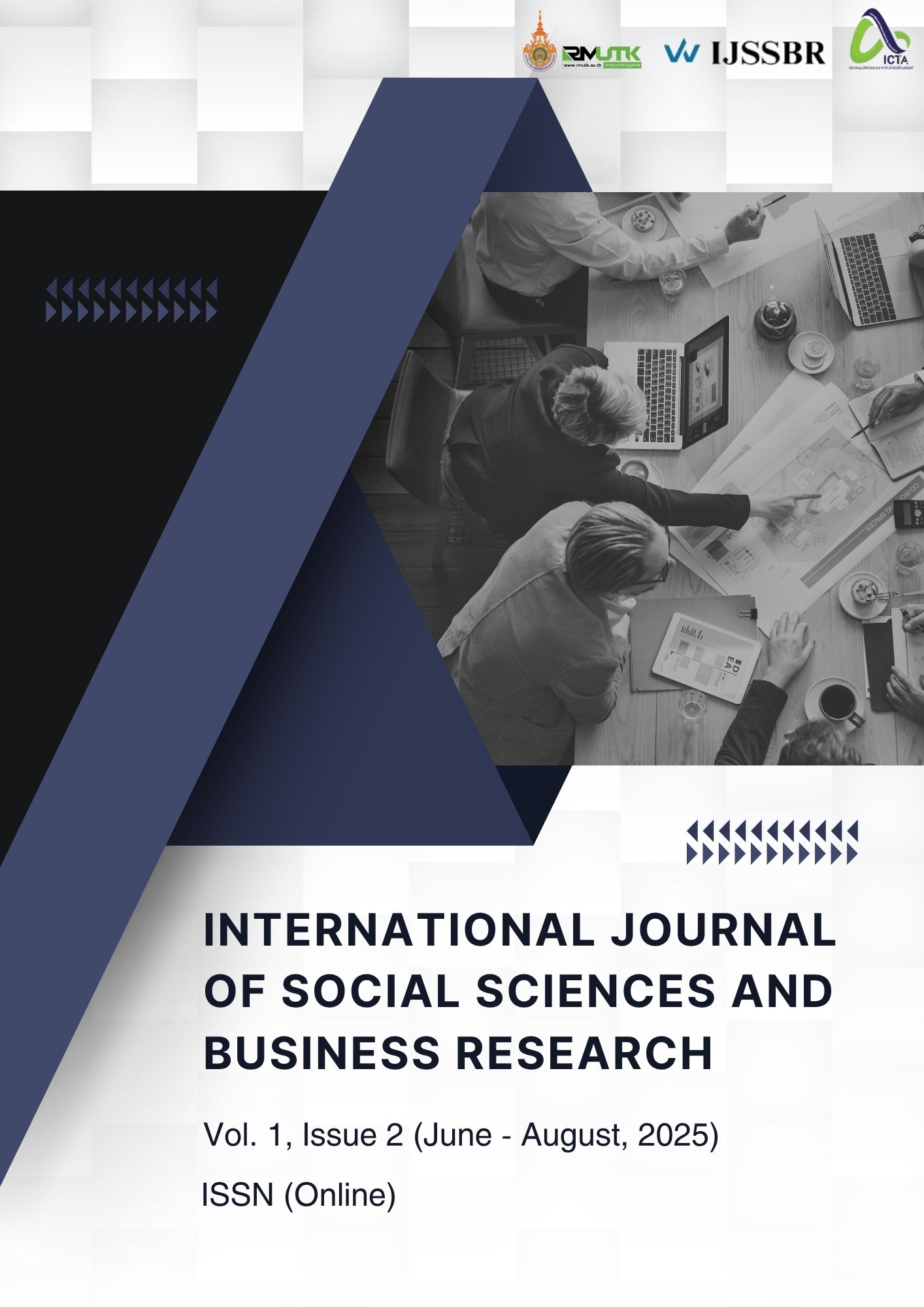Transformational Leadership and Employee Loyalty in Chinese Service SMEs: Emotional Regulation and Communication as Mediators
Keywords:
Transformational Leadership, Employee Loyalty, Service Industries, Emotional Regulation, Organizational CommunicationAbstract
This study examines how transformational leadership, emotional regulation, and organizational communication jointly shape employee loyalty in service-focused small and medium-sized enterprises (SMEs) within Shandong Province, China. Drawing on Social Exchange Theory, Leader–Member Exchange Theory, and the Job Demands–Resources Model, the research proposes that transformational leadership exerts a direct influence on employee loyalty. Further, it positions emotional regulation as a mediating mechanism by which employees enhance their capacity to handle the emotional demands characteristic of service-intensive roles. Organizational communication is explored as an additional factor that moderates and strengthens the positive relationships among transformational leadership, emotional regulation, and employee loyalty, thereby offering a more nuanced perspective on workplace dynamics in SMEs.
Survey data were collected from 425 SME employees and analyzed using structural equation modeling. Results indicate that transformational leadership is significantly associated with employee loyalty (standardized path coefficient = 0.62, p < 0.001). Emotional regulation also emerges as a critical mediator (β = 0.61, p < 0.001), demonstrating a partial indirect effect on the leadership–loyalty link. Moreover, organizational communication further amplifies these effects, underscoring its importance as a moderating construct. Theoretically, these findings expand our understanding of transformational leadership by highlighting how cultural and structural elements of Chinese SMEs—particularly robust communication channels and emotional-regulation strategies—serve as key resources for employees. Practically, this study emphasizes the need for leadership-development programs, emotional-support initiatives, and effective communication systems to strengthen employee loyalty, reduce turnover, and bolster organizational performance in service-based enterprises.
References
Allen, N. J., & Meyer, J. P. (1990). The measurement and antecedents of affective, continuance and normative commitment to the organization. Journal of Occupational Psychology, 63(1), 1–18. https://doi.org/10.1111/j.2044-8325.1990.tb00506.x
Anderson, J. C., & Gerbing, D. W. (1988). Structural equation modeling in practice: A review and recommended two‐step approach. Psychological Bulletin, 103(3), 411–423. https://doi.org/10.1037/0033-2909.103.3.411
Avolio, B. J., & Yammarino, F. J. (2013). Transformational and charismatic leadership: The road ahead (2nd ed.). Emerald Group Publishing.
Bakker, A. B., & Demerouti, E. (2007). The job demands–resources model: State of the art. Journal of Managerial Psychology, 22(3), 309–328. https://doi.org/10.1108/02683940710733115
Bass, B. M., & Riggio, R. E. (2006). Transformational leadership (2nd ed.). Lawrence Erlbaum Associates.
Blau, P. M. (1964). Exchange and power in social life. Wiley.
Brotheridge, C. M., & Lee, R. T. (2002). Testing a conservation of resources model of the dynamics of emotional labor. Journal of Occupational Health Psychology, 7(1), 57–67. https://doi.org/10.1037/1076-8998.7.1.57
Burns, J. M. (1978). Leadership. Harper & Row.
Chai, W. (2023). Employee loyalty and organizational performance: Evidence from service industries. Journal of Organizational Behavior, 44(3), 301–321. https://doi.org/10.1002/job.2630
Choi, S. L., Goh, C. F., Adam, M. B. H., & Tan, O. K. (2016). Transformational leadership, empowerment, and job satisfaction: The mediating role of employee empowerment. Human Resources for Health, 14, 73. https://doi.org/10.1186/s12960-016-0156-2
Clampitt, P. G. (2016). Communicating for managerial effectiveness (6th ed.). Sage.
Creswell, J. W. (2014). Research design: Qualitative, quantitative, and mixed methods approaches (4th ed.). Sage.
Cropanzano, R., & Mitchell, M. S. (2005). Social exchange theory: An interdisciplinary review. Journal of Management, 31(6), 874–900. https://doi.org/10.1177/0149206305279602
Daft, R. L., & Lengel, R. H. (1986). Organizational information requirements, media richness and structural design. Management Science, 32(5), 554–571. https://doi.org/10.1287/mnsc.32.5.554
Fornell, C., & Larcker, D. F. (1981). Evaluating structural equation models with unobservable variables and measurement error. Journal of Marketing Research, 18(1), 39–50. https://doi.org/10.2307/3151312
Grandey, A. A. (2003). When “the show must go on”: Surface acting and deep acting as determinants of emotional exhaustion and peer‐rated service delivery. Academy of Management Journal, 46(1), 86–96. https://doi.org/10.5465/30040678
Gross, J. J. (1998). The emerging field of emotion regulation: An integrative review. Review of General Psychology, 2(3), 271–299. https://doi.org/10.1037/1089-2680.2.3.271
Heskett, J. L., Sasser, W. E., & Schlesinger, L. A. (1997). The service profit chain. Free Press.
Hochschild, A. R. (1983). The managed heart: Commercialization of human feeling. University of California Press.
Humphrey, R. H., Ashforth, B. E., & Diefendorff, J. M. (2015). The bright side of emotional labor. Journal of Organizational Behavior, 36(6), 749–769. https://doi.org/10.1002/job.2012
Judge, T. A., & Piccolo, R. F. (2004). Transformational and transactional leadership: A meta‐analytic test of their relative validity. Journal of Applied Psychology, 89(5), 755–768. https://doi.org/10.1037/0021-9010.89.5.755
Karanges, E., Beatson, A., Johnston, K., & Lings, I. (2015). The influence of internal communication on employee engagement: A pilot study. Public Relations Review, 41(1), 129–131. https://doi.org/10.1016/j.pubrev.2014.10.010
Men, L. R., & Stacks, D. W. (2014). The effects of authentic leadership on strategic internal communication and employee–organization relationships. Journal of Public Relations Research, 26(4), 301–324. https://doi.org/10.1080/1062726X.2014.956106
Meyer, J. P., & Allen, N. J. (1991). A three‐component conceptualization of organizational commitment. Human Resource Management Review, 1(1), 61–89. https://doi.org/10.1016/1053-4822(91)90011-Z
Mowday, R. T., Steers, R. M., & Porter, L. W. (1979). The measurement of organizational commitment. Journal of Vocational Behavior, 14(2), 224–247. https://doi.org/10.1016/0001-8791(79)90072-1
Nunnally, J. C., & Bernstein, I. H. (1994). Psychometric theory (3rd ed.). McGraw‐Hill.
Podsakoff, P. M., MacKenzie, S. B., Paine, J. B., & Bachrach, D. G. (2000). Organizational citizenship behaviors: A critical review and meta‐analysis. Journal of Management, 26(3), 513–563. https://doi.org/10.1177/014920630002600307
Rhoades, L., & Eisenberger, R. (2002). Perceived organizational support: A review of the literature. Journal of Applied Psychology, 87(4), 698–714. https://doi.org/10.1037/0021-9010.87.4.698
Yamane, T. (1967). Statistics: An introductory analysis (2nd ed.). Harper & Row.
Yang, J. (2023). Competitive dynamics in service industries amidst globalization and digital transformation. Service Science Review, 12(1), 45–62.
Downloads
Published
How to Cite
Issue
Section
License
Copyright (c) 2025 Rajamangala University of Technology Krungthep

This work is licensed under a Creative Commons Attribution-NonCommercial-NoDerivatives 4.0 International License.






